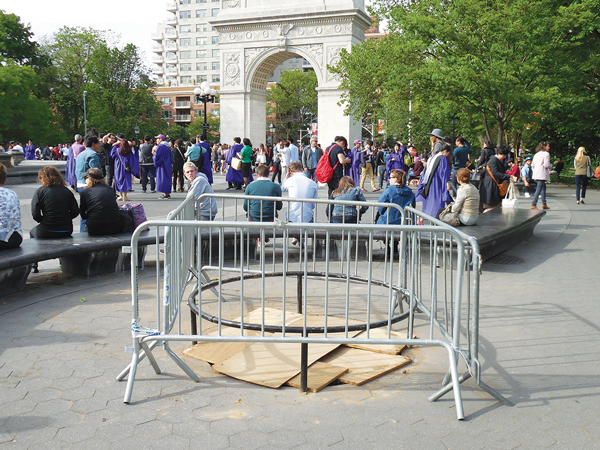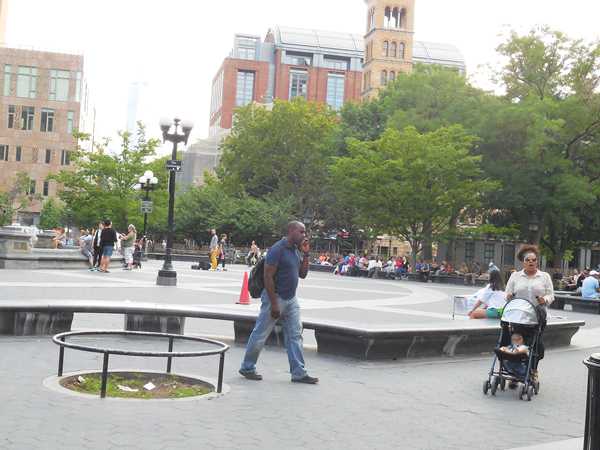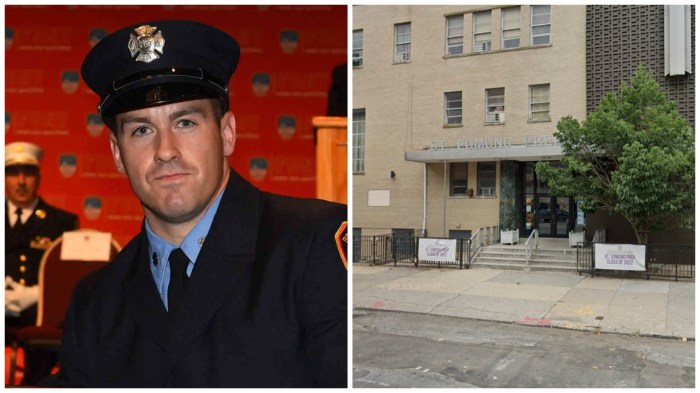
BY SHARON WOOLUMS | Hate to say “I told you so”…but, actually, isn’t there always a bit of delicious satisfaction knowing we were right…right? In a way, yes, but no, this is too dire.
Desperately needed trees dying left and right, being replaced again and again to no avail — no fun gloating here! It’s too sad and pathetic to watch all of us clamoring to find a square inch of shade around the fountain of one of the most famous parks in the world. Unfortunately, without trees, our beloved Washington Square Park more resembles a corporate plaza than a park.
Once upon a time in Washington Square Park there were huge trees surrounding the fountain, comfortable benches to sit on, and musicians that respected each other’s auditory space. But that was pre-redesign. Regular park users have bemoaned some of the changes resulting from the $32 million project ever since.
When the main reconstruction of the park was finished, I wrote about “the spontaneous creativity that happened naturally here” and the hope that “that glorious time will not die, like the tree in the circle.”
Never could I have imagined having to add an “S” to tree! Now three zelkova elms around the “Tisch Fountain” are down, with five to go — and yet another just turned brown! Once again, and then again and again, recently replaced trees didn’t make the transplant — some say they died of a heartache!
Without shade, musicians and their audiences are finding the park, along with its hot-as-hell (freezing-in-winter) black granite mausoleum benches around the fountain, downright user-unfriendly! Though some regulars have left, others, though diminished in number, despite the discomfort, are determined to keep the spirit of our park alive — and they do it well!
Tobi Bergman, the Community Board 2 chairperson and a former Parks Department employee, mentioned in a recent C.B. 2 Parks Committee meeting that the current design for these eight trees is not working and they should be planted at ground level.

In 2009 I did a walk-around of the park with a tree expert, Richard Hawthorne of Hawthorne Bros. Tree Service, Inc., of Bedford Hills, New York. He recognized then that there would be little hope for the survival of these trees, given the tree pits in which they were planted. Lacking proper drainage, this decision — without benefit of a reputable arborist’s expertise — was a huge mistake on the part of the architect who designed the park’s reconstruction.
As Hawthorne explained, “A tree’s root system extends three times the length of the radius of the drip line” — the tree’s outermost leaves — “where roots have the freedom to grow without any constrictions or impediments.
“Instead of planting them in a pit,” he said, “they should have been planted at ground level, with a small retaining wall built around them, the same diameter as the pits — preferably larger, making sure holes are built at the base of the walls to allow excess water to drain off. The walls could even double as a bench for people to sit on while listening to music, for which our park is known,” he noted.
Hmm…similar to what we had before…just sayin’!
Even in 2009, Hawthorne noticed tips of the other fountain trees were “dying back,” meaning they were in the process of dying. Since the tips are farthest from the feeder roots, it means the tree does not have enough strength to send nutrients to the branches’ ends — which are the first to show the effects of stress. The small offshoots near the tree’s base, called “sucker growth,” found on the fountain trees, are indicative of the same problem.
And then there are the telltale cracks in the bark, yet another sign of an advanced state of decline. Of course, the bark and roots of dying trees are more susceptible to being invaded by insects and disease.
We all crave the shade in the heat of summer, but due to increased skin sensitivity for those on medications, as well as children and the elderly, lack of shade is a serious problem.
Chopping down trees, transplanting and replanting is prohibitively expensive. Nobody wants the disruption of tearing up the heart of the park once again — it’s the pits! Excuse the pun.
But mistakes were made. It is time to acknowledge that, own up, and finally redesign the redesigned pits for future park lovers.
Park activists who fought valiantly against the recent redesign had admonished, “If it ain’t broke, don’t fix it.” Now the fix is in…but it’s broken!
We have a right to expect shade in the most important part of the park, and we have a right to oxygen too…and some of us have earned the right to complain! Tree huggers unite…we still have some bark left in us!
Woolums is a public member, C.B. 2 Parks and Waterfront Committee, and in the mid-2000s was the point person on the lawsuit by Emergency Coalition Organization to Save Washington Square Park (ECO) against the Washington Square Park reconstruction project.

















